Blog & Latest Updates
Fly Fishing Articles
Insects by Common Name


Insect Order Trichoptera (Caddisflies)
Taxonomic Navigation -?-
Kingdom
Animalia (Animals)
» Phylum
Arthropoda (Arthropods)
» Class
Insecta (Insects)
» Order Trichoptera (Caddisflies)
5 families aren't included.
Common Name
| Match | Common Name |
| Caddisflies |
This is page 11 of specimens of Trichoptera. Visit the main Trichoptera page for:
- The behavior and habitat of Trichoptera.
- 55 underwater pictures of Trichoptera.
Pictures of 129 Caddisfly Specimens:
Limnephilidae (Northern Caddisflies) Caddisfly Larva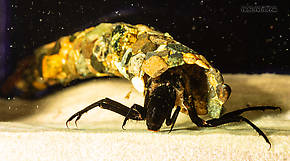 View 15 Pictures
View 15 Pictures
 View 15 Pictures
View 15 PicturesCollected June 13, 2019 from the South Fork Snoqualmie River in Washington
Added to Troutnut.com by Troutnut on June 15, 2019
Added to Troutnut.com by Troutnut on June 15, 2019
Male Leptoceridae Caddisfly Adult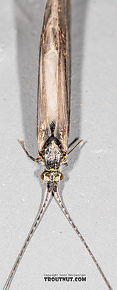 View 6 Pictures
View 6 Pictures
 View 6 Pictures
View 6 PicturesCollected June 30, 2019 from the Madison River in Montana
Added to Troutnut.com by Troutnut on July 17, 2019
Added to Troutnut.com by Troutnut on July 17, 2019
Hydropsychidae Caddisfly Adult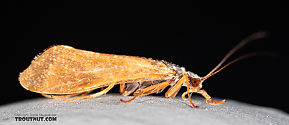 View 8 Pictures
View 8 Pictures
 View 8 Pictures
View 8 PicturesCollected July 8, 2019 from the Ruby River in Montana
Added to Troutnut.com by Troutnut on July 18, 2019
Added to Troutnut.com by Troutnut on July 18, 2019
Helicopsyche borealis (Speckled Peter) Caddisfly Pupa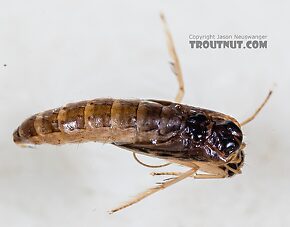 View 13 PicturesI'm calling this one very tentatively Helicopsyche borealis, with some big caveats that I might be wrong.
View 13 PicturesI'm calling this one very tentatively Helicopsyche borealis, with some big caveats that I might be wrong.
It seems to key fairly easily to Helicopsychidae, except at the last couplet in Merritt & Cummins (5th ed) it's supposed to have “anal processes short and straight, each with several mesal (Mesal: Toward the middle.) setae (Seta: Little hairs on insects.) and 2 long apical (Apical: Close to the apex; tip or end.) setae (Seta: Little hairs on insects.),” whereas this one has VERY short, straight processes with 3 long apical (Apical: Close to the apex; tip or end.) setae (Seta: Little hairs on insects.) and no mesal (Mesal: Toward the middle.) ones.
Additionally, the only species of Helicopsychidae documented in this region is Helicopsyche borealis, which is supposed to emerge much later in the summer.
 View 13 PicturesI'm calling this one very tentatively Helicopsyche borealis, with some big caveats that I might be wrong.
View 13 PicturesI'm calling this one very tentatively Helicopsyche borealis, with some big caveats that I might be wrong.It seems to key fairly easily to Helicopsychidae, except at the last couplet in Merritt & Cummins (5th ed) it's supposed to have “anal processes short and straight, each with several mesal (Mesal: Toward the middle.) setae (Seta: Little hairs on insects.) and 2 long apical (Apical: Close to the apex; tip or end.) setae (Seta: Little hairs on insects.),” whereas this one has VERY short, straight processes with 3 long apical (Apical: Close to the apex; tip or end.) setae (Seta: Little hairs on insects.) and no mesal (Mesal: Toward the middle.) ones.
Additionally, the only species of Helicopsychidae documented in this region is Helicopsyche borealis, which is supposed to emerge much later in the summer.
Collected April 9, 2021 from the Yakima River in Washington
Added to Troutnut.com by Troutnut on April 12, 2021
Added to Troutnut.com by Troutnut on April 12, 2021
Rhyacophila carolina (Green Sedge) Caddisfly Larva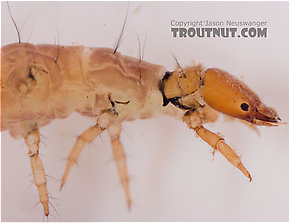 View 8 PicturesThis specimens shows that the name "green rockworm" doesn't quite fit all Rhyacophila larvae, even though it does fit the majority. This is actually the first of their larvae that I've found in a different color. I'm not sure if it's because of the species or because this is a young one, but I have found equally small green larvae, so I'm guessing it's the species.
View 8 PicturesThis specimens shows that the name "green rockworm" doesn't quite fit all Rhyacophila larvae, even though it does fit the majority. This is actually the first of their larvae that I've found in a different color. I'm not sure if it's because of the species or because this is a young one, but I have found equally small green larvae, so I'm guessing it's the species.
 View 8 PicturesThis specimens shows that the name "green rockworm" doesn't quite fit all Rhyacophila larvae, even though it does fit the majority. This is actually the first of their larvae that I've found in a different color. I'm not sure if it's because of the species or because this is a young one, but I have found equally small green larvae, so I'm guessing it's the species.
View 8 PicturesThis specimens shows that the name "green rockworm" doesn't quite fit all Rhyacophila larvae, even though it does fit the majority. This is actually the first of their larvae that I've found in a different color. I'm not sure if it's because of the species or because this is a young one, but I have found equally small green larvae, so I'm guessing it's the species.Collected May 6, 2007 from Mongaup Creek in New York
Added to Troutnut.com by Troutnut on May 18, 2007
Added to Troutnut.com by Troutnut on May 18, 2007
Neophylax (Autumn Mottled Sedges) Caddisfly Larva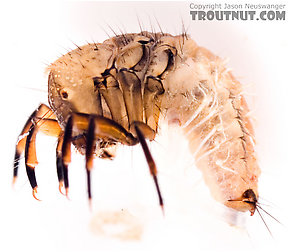 View 7 PicturesThe size of the head compared to the body in this larva is surprising, and I think this means it's a fairly early instar (Instar: Many invertebrates molt through dozens of progressively larger and better-developed stages as they grow. Each of these stages is known as an instar. Hard-bodied nymphs typically molt through more instars than soft-bodied larvae.) of something which is going to get a lot bigger, but I'm not sure.
View 7 PicturesThe size of the head compared to the body in this larva is surprising, and I think this means it's a fairly early instar (Instar: Many invertebrates molt through dozens of progressively larger and better-developed stages as they grow. Each of these stages is known as an instar. Hard-bodied nymphs typically molt through more instars than soft-bodied larvae.) of something which is going to get a lot bigger, but I'm not sure.
 View 7 PicturesThe size of the head compared to the body in this larva is surprising, and I think this means it's a fairly early instar (Instar: Many invertebrates molt through dozens of progressively larger and better-developed stages as they grow. Each of these stages is known as an instar. Hard-bodied nymphs typically molt through more instars than soft-bodied larvae.) of something which is going to get a lot bigger, but I'm not sure.
View 7 PicturesThe size of the head compared to the body in this larva is surprising, and I think this means it's a fairly early instar (Instar: Many invertebrates molt through dozens of progressively larger and better-developed stages as they grow. Each of these stages is known as an instar. Hard-bodied nymphs typically molt through more instars than soft-bodied larvae.) of something which is going to get a lot bigger, but I'm not sure.Collected May 6, 2007 from the Neversink River (above reservoir) in New York
Added to Troutnut.com by Troutnut on May 10, 2007
Added to Troutnut.com by Troutnut on May 10, 2007
Onocosmoecus unicolor (Great Late-Summer Sedge) Caddisfly Adult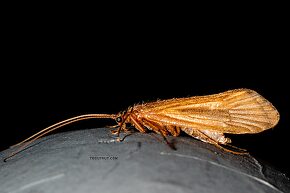 View 11 PicturesOne key characteristic not clearly photographed, but clear in under the microscope: this specimen's midtibiae have 2 apical (Apical: Close to the apex; tip or end.) spurs and 1 preapical spur.
View 11 PicturesOne key characteristic not clearly photographed, but clear in under the microscope: this specimen's midtibiae have 2 apical (Apical: Close to the apex; tip or end.) spurs and 1 preapical spur.
 View 11 PicturesOne key characteristic not clearly photographed, but clear in under the microscope: this specimen's midtibiae have 2 apical (Apical: Close to the apex; tip or end.) spurs and 1 preapical spur.
View 11 PicturesOne key characteristic not clearly photographed, but clear in under the microscope: this specimen's midtibiae have 2 apical (Apical: Close to the apex; tip or end.) spurs and 1 preapical spur.Collected August 4, 2020 from Trealtor Creek in Idaho
Added to Troutnut.com by Troutnut on August 20, 2020
Added to Troutnut.com by Troutnut on August 20, 2020
Brachycentridae (Apple Caddis and Grannoms) Caddisfly Pupa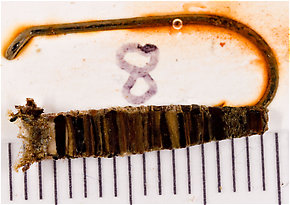 View 9 Pictures
View 9 Pictures
 View 9 Pictures
View 9 PicturesCollected May 6, 2007 from Mongaup Creek in New York
Added to Troutnut.com by Troutnut on May 18, 2007
Added to Troutnut.com by Troutnut on May 18, 2007
Cheumatopsyche (Little Sister Sedges) Caddisfly Pupa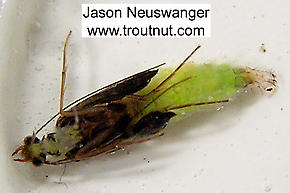 View 3 PicturesI was surprised how bright green this pupa is. It's chartreuse. After collecting it, I experimented with melting down chartreuse jigs and making little translucent rubber caddis abdomens on my flies. They looked good, and the trout liked them, but they weren't very durable at all. This specimen is recently deceased in the photographs.
View 3 PicturesI was surprised how bright green this pupa is. It's chartreuse. After collecting it, I experimented with melting down chartreuse jigs and making little translucent rubber caddis abdomens on my flies. They looked good, and the trout liked them, but they weren't very durable at all. This specimen is recently deceased in the photographs.
 View 3 PicturesI was surprised how bright green this pupa is. It's chartreuse. After collecting it, I experimented with melting down chartreuse jigs and making little translucent rubber caddis abdomens on my flies. They looked good, and the trout liked them, but they weren't very durable at all. This specimen is recently deceased in the photographs.
View 3 PicturesI was surprised how bright green this pupa is. It's chartreuse. After collecting it, I experimented with melting down chartreuse jigs and making little translucent rubber caddis abdomens on my flies. They looked good, and the trout liked them, but they weren't very durable at all. This specimen is recently deceased in the photographs.Collected May 18, 2004 from the Namekagon River in Wisconsin
Added to Troutnut.com by Troutnut on January 25, 2006
Added to Troutnut.com by Troutnut on January 25, 2006
Philopotamidae Caddisfly Larva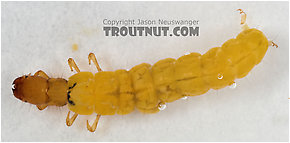 View 2 Pictures
View 2 Pictures
 View 2 Pictures
View 2 PicturesCollected March 13, 2005 from Cascadilla Creek in New York
Added to Troutnut.com by Troutnut on April 5, 2006
Added to Troutnut.com by Troutnut on April 5, 2006
Top 10 Fly Hatches
Top Gift Shop Designs
Eat mayflies.
Top Insect Specimens
Miscellaneous Sites
Troutnut.com is copyright © 2004-2024 Jason
Neuswanger (email Jason). See my FAQ for information about use of my images.
 privacy policy
privacy policy
